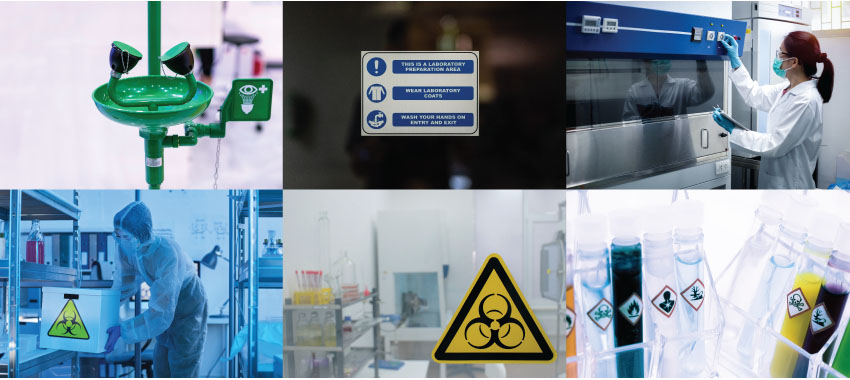
Alongside being the origin of discovery and innovation, laboratories are also home to many potential hazards along the way. Whatever the scientific field, it doesn’t come without risks – from radiation and biohazards to chemical exposure or even electrical danger.
This is why such environments need to be equipped with lab safety warning symbols as part of the compulsory measures taken to protect researchers, students, and other personnel.
Here, we talk more about lab safety rules and the importance of safety signs in the lab, before breaking down laboratory symbols and their meanings.
The Importance of Lab Safety Rules
Guidelines on safety and dealing with potential hazards are equally important in all lab environments, whether it’s a school science lab, an academic research facility, or a commercial testing site. Lab safety rules normally cover:
Personal protective equipment (PPE) – Depending on their work, lab researchers might be required to wear a range of protective equipment, including goggles, lab coats, and gloves, as well as more specialist pieces such as respirators and face shields in certain cases. This way, they’re protected from biological contaminants, chemical spills, and airborne hazardous substances.
Emergency equipment use – Even with the most careful handling, accidents do happen. That’s why it’s important that everyone using the lab knows how to locate essential emergency equipment such as fire extinguishers, first aid kits, eyewash stations, and emergency showers. Accessing these quickly can help avoid serious harm or accident escalation.
Material handling training – Those working with biohazards, radioactive materials, or other harmful chemicals should all be trained on the proper safety procedures for handling them. This includes everything from understanding laboratory signs and symbols and their meanings, to proper storage, labelling, disposal, containment, and decontamination.
Regulations on Safety Symbols in the Laboratory
It’s not just best practice to label hazards properly in a laboratory – in many cases, it’s actually required by law. Part of a laboratory manager’s duty of care includes making sure that safety signs in the lab adhere to UK health and safety regulations, such as:
The Health and Safety (Safety Signs and Signals) Regulations 1996 – These regulations apply to all workplaces, enforcing standardised health and safety signage. In a laboratory environment, this includes clearly displaying emergency equipment signs, hazard warnings, and mandatory actions.
Control of Substances Hazardous to Health (COSHH) – A set of regulations specifically compiled for the safety of workers handling hazardous substances, which mandates appropriate risk assessment, control measures, and COSHH signs instructing lab workers about risks and handling procedures.
The Classification, Labelling and Packaging (CLP) Regulation – Now referred to as GB CLP, this EU directive was introduced to create standardised hazardous chemicals classification, allowing for the safe packaging and labelling of such materials. This way, workers from all industries and European countries can quickly identify potential dangers.
Having standardised safety symbols in the laboratory has the dual benefit of keeping your organisation compliant, while also safeguarding everyone using the lab.
Types of Safety Signs in the Lab
The various risks of a laboratory depend on the field your organisation is in, as well as the specific materials and equipment you work with. That said, some common dangers include:
- Biological hazards: blood samples, microorganisms, pathogens, infectious materials, clinical waste
- Chemical hazards: reactive materials, flammables, corrosives, toxic fumes, oxidising substances
- Radiation hazards: radiologically active compounds, X-ray equipment, non-ionising radiation, ultraviolet (UV) radiation and high-intensity light sources
- Mechanical hazards: heavy and/or fast-moving equipment (e.g. centrifuges, mixers, evaporators), magnetic fields
- Electrical hazards: static discharge, live wiring, high-voltage
You can mitigate these risks by clearly displaying lab safety rules for usage, along with the appropriate lab safety labels denoting each of the hazards.
Supporting Lab Safety Rules, with Label Source
Clear lab safety rules backed by compliance-led visual safety warnings and regular training help encourage vigilance and responsible behaviour within laboratory workplaces.
Safety symbols in the laboratory communicate various dangers clearly, both to regular employees and first-time visitors, so that everyone is aware of where risks are present and how to handle them.
Our range of lab safety labels uses globally recognised colour codes and icons to comply with safety standards. We make all our labels and tapes from durable materials designed to withstand chemical exposure, high humidity, and more – making them the ideal safety signs in the lab.
Not sure exactly which safety label you need? Contact our team, and we’ll help you find all the essentials.